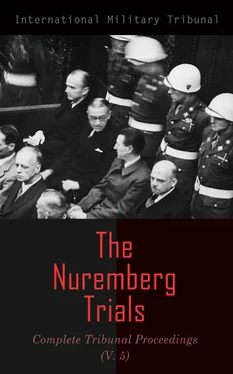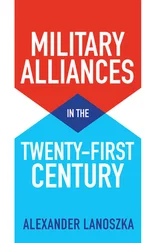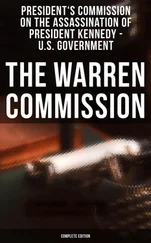It is believed that Schacht joined the Party only in the sense that he allied himself with the cause. Dr. Franz Reuter, whose biography of Schacht was officially published in Germany in 1937, has stated that Schacht refrained from formal membership in order to be of greater assistance to the Party. I offer in evidence Document Number EC-460, Exhibit Number USA-617, consisting of an excerpt from Reuter’s biography, and I quote the last sentence of the excerpt:
“By not doing so, he was able eventually to help more toward the final victory than if he had become an enrolled Party member.”
It was Schacht who organized the financial means for the decisive March 1933 election, at a meeting of Hitler with a group of German industrialists in Berlin. Schacht acted as the sponsor or host of this meeting, and a campaign fund of several million marks was collected. Without reading therefrom, I offer in evidence Document Number EC-439, Exhibit Number USA-618, an affidavit of Von Schnitzler under date of 10 November 1945, and refer the Tribunal to the transcript for 23 November, Pages 282-283 (Volume II, Pages 223, 224), where the text of the affidavit already appears in the Record.
Further evidence on this point is also contained in the excerpt from the interrogation of Schacht on 20 July 1945, from which I read a part a moment ago. Schacht lent his support to Hitler not only because he was an opportunist, but also because he shared Hitler’s ideological principles. Apart from the entry in Goebbels’ diary, this may be seen from Schacht’s own letter to Hitler, under date of 29 August 1932, pledging continued support to Hitler after the latter’s poor showing in the July 1932 elections. I offer this letter in evidence as Document Number EC-457, Exhibit Number USA-619, and quote from the middle of the first paragraph and further from the next to the last paragraph:
“But what you could perhaps do with in these days is a kind word. Your movement is carried internally by so strong a truth and necessity that victory in one form or another cannot elude you for long.”
And further down—and keep in mind that neither Hitler nor Schacht was then in the German Government—Schacht says:
“Wherever my work may take me in the near future, even if you should see me one day behind stone walls, you can always count on me as your reliable assistant.”
THE PRESIDENT: What do those words mean at the top: “The President of the Reichsbank in Retirement”? Are they on the letter?
LT. BRYSON: Yes, they are, Sir. Dr. Schacht had previously been a president of the Reichsbank. At this time he was in retirement. You will remember, this is prior to Hitler’s accession to power.
THE PRESIDENT: Yes, of course.
LT. BRYSON: And then Hitler reinstated Dr. Schacht as President of the Reichsbank after the Nazis had taken over.
THE PRESIDENT: And he put that at the top of his letter, did he?
LT. BRYSON: That I cannot say.
I will also point out that Schacht signed this letter, “With a vigorous Heil.”
We turn now to the second part of our proof, relating to Schacht’s contribution to preparation for war.
The detailed chronology of Schacht’s official career in the Nazi Government, as set forth in Document 3021-PS, has already been submitted in evidence as Exhibit Number USA-11. However, it may be helpful at the outset to remind the Tribunal that Schacht was recalled to the Presidency of the Reichsbank by Hitler on 17 March 1933, which office he continuously held until 20 January 1939; that he was Acting Minister and then Minister of Economics from August 1934 until November 1937; and that he was appointed Plenipotentiary General for War Economy in May 1935. He resigned as Minister of Economics and Plenipotentiary General for War Economy in November 1937, when he accepted appointment as Minister without Portfolio, which post he held until January 1943. His position as virtual economic dictator of Germany in the 4 crucial years from early 1933 to the end of 1936 is practically a matter of common knowledge.
Schacht was the guiding genius behind the Nazi expansion of the German credit system for rearmament purposes. From the outset he recognized that the plan for the German military supremacy required huge quantities of public credit. To that end a series of measures was adopted which subverted all credit institutions in Germany to the over-all aim of supplying funds for the military machine. I will briefly mention some of these measures.
By Cabinet decree of 27 October 1933 the statutory reserve of 40 percent in gold and foreign exchange required against circulating Reichsbank notes was permanently abandoned. By the Credit Act of 1934 the Government assumed jurisdiction of all credit institutions, and control over the entire banking system was centralized in Schacht as Chairman of the Supervisory Board for the Credit System and President of the Reichsbank. This act not only enabled Schacht to control the quantity of credit but also its use. On 29 March 1934 a system of forced corporate lending to the Reich was imposed on German business. And on 19 February 1935 the Treasury was authorized to borrow funds in any amounts approved by the Reich Chancellor, that is, by Hitler.
On these points I ask the Tribunal to take judicial notice of the Reichsgesetzblatt 1933, Part II, Page 827; Reichsgesetzblatt 1934, Part I, Page 1203; Reichsgesetzblatt 1934, Part I, Page 295; and Reichsgesetzblatt 1935, Part I, Page 198.
THE PRESIDENT: Are they found here in the document book?
LT. BRYSON: They’re not in the document book, Sir.
I asked only that judicial notice be taken of them as published laws of Germany.
These measures enabled Schacht to embark upon what he himself has termed a “daring credit policy,” including the secret financing of a vast amount of armaments through the so-called ‘mefo’ bill, a description of which appears in the transcript for 23 November at Page 295 (Volume II, Page 232). I offer in evidence Document Number EC-436, Exhibit Number USA-620, consisting of a statement, dated 2 November 1945, by Emil Puhl, a director of the Reichsbank during Schacht’s presidency, and quote the second paragraph thereof as follows:
“In the early part of 1935 the need for financing an accelerated rearmament program arose. Dr. Schacht, President of the Reichsbank, after considering various techniques of financing, proposed the use of mefo bills to provide a substantial portion of the funds needed for the rearmament program. This method had as one of its primary advantages the fact that secrecy would be possible during the first years of the rearmament program; and figures indicating the extent of rearmament, that would have become public through the use of other methods, could be kept secret through the use of mefo bills.”
The extent of the credit expansion and the importance of mefo financing may be seen from Document Number EC-419, which I now offer as Exhibit Number USA-621 and which consists of a letter from Finance Minister Von Krosigk to Hitler, under date of 1 September 1938. I quote the following figures from the middle of the first page:
“The Reich debt accumulated as follows:
“As of 31 December 1932: Funded debt, 10,400 millions of Reichsmark; short-term debt, 2,100 millions of Reichsmark; debt not published in the budget (trade and mefo bills of exchange), 0.
“As of 30 June 1938: Funded debt, 19,000 million Reichsmark; short-term debt, 3,500 million Reichsmark; and debt not published in the budget (trade and mefo bills of exchange), 13,300 million Reichsmark.
“Total: as of 31 December 1932, 12,500 million Reichsmark; as of 30 June 1938, 35,800 million Reichsmark.”
The Reich debt thus tripled. . .
THE PRESIDENT: Would you read the next section, beginning with the words “Provisions were made to cover. . .”?
Читать дальше












